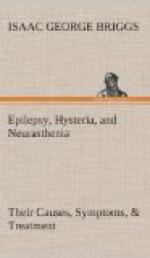Course and Outlook. Neurasthenia is very curable. If the cause be removed, and vigorous treatment instituted, the victim may be well in a couple of months, but in most cases there are obstacles to radical treatment, and the disease drags on indefinitely.
Egoism, moral cowardice, and sexual excess play a part in much neurasthenia, but relatives must not forget, in their indignation at these laxities, that the patient really is ill; it is unkind, unjust and useless to tell an ailing man the unpalatable truth that it is his own fault.
* * * * *
CHAPTER VIII
HYSTERIA
“Diseased nature oftentimes
breaks forth
In strange eruptions; ...”
“King Henry IV.”
Hysteria, recorded in legend and law, in manuscript and marble, in folk-lore and chronicle, right from history’s dawn, is still a puzzle of personality, and only equalled by syphilis in the protean nature of its manifestations.
The sacred books of the East said delayed menstruation due to a devil was its cause; the thrashing-out of the devil its cure. Chinese legends describe it, and its symptoms were ascribed by the Inquisition to witchcraft and sorcery.
Old Egyptian papyri tell how to dislodge the devil from the stomach, and there were hysteria specialists in 450 B.C. All old theories fix on the womb as the seat of the disease. The name hysteria is the Greek word for womb, and 97 per cent of patients are women.
A few of the very numerous modern theories may be noticed.
The unconscious (or the subconscious) and the conscious are only parts of one whole. Our “conscious” activities are those which have developed late in the history of the race, and which develop comparatively late in the history of the individual. The “conscious” is the product of the racial education of the “unconscious”; the first is the man, the modern, the civilized; the last is the child, the primitive, the savage. Between the two there is no gulf fixed, and the Oxford metaphysician need not go to Timbuctoo to seek a superstitious savage; he may find one within himself.
In hysteria, Janet says, the field of consciousness is narrowed, and the patient lives through subconscious experiences, which she forgets when she again “comes to”. She journeys back into the past, back a few years individually, back centuries or aeons racially, and becomes a savage child again.
Normally, when anything goes wrong, or we suffer from excessive emotion, we give vent to our feelings by tears, abuse, anger, or impulsive action; in some way we “hit back”, and relieve ourselves of the feeling of oppression. Then we forget, which heals the sore, and closes the experience.
If, at the moment, we bottle up our emotions, they obtrude later at inconvenient times until we “get them off our mind” by confiding in some one, when we get peace of mind. Open confession is good for the soul, and it is better to “cry your eyes out” than to “eat your heart out”.




